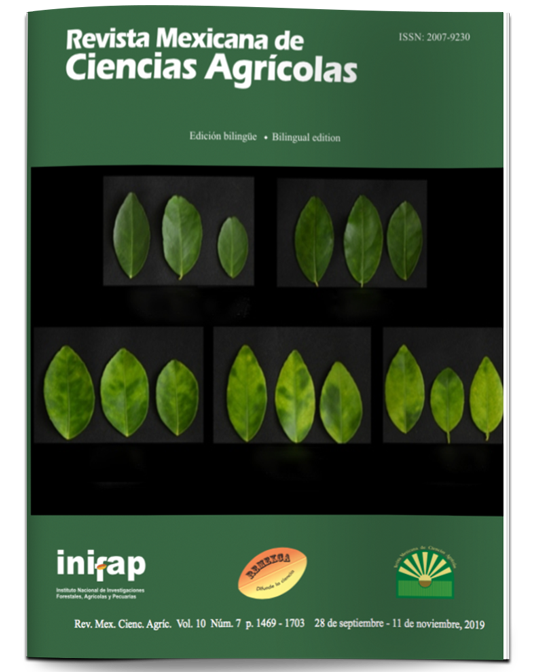Detection of genetic markers associated with resistance to pathogens in ayocote beans from Puebla, Mexico
DOI:
https://doi.org/10.29312/remexca.v10i7.1956Keywords:
: Colletotrichum lindemuthianum, Phaseolus pathogens and Xanthomonas axonopodis pv. Phaseoli, Carso HuastecoAbstract
Ayocote beans (Phaseolus coccineus L.); 2n= 2x= 22) is a legume native to the highlands of Mexico, it is important in human nutrition and detection of improvement characteristics, it shows resistance to pathogens and certain abiotic factors that cause losses in the bean crop. With the premise of identifying Phaseolus germplasm with multiple resistance to biotic and abiotic adverse factors, this work was carried out with the objective of this work was to determine the resistance or susceptibility to two important pathogens: common blight [Xanthomonas axonopodis pv. phaseoli (Smith)] and anthracnose [Colletotrichum lindemutianum Sacc. & Magn (anamorph Glomerella lindemuthiana Shear)] based on the identification of sequences characterized by amplified regions (SCARs). The study included 117 accessions collected at different sites in Puebla, Mexico (region called Carso Huasteco), which were analyzed with 10 SCAR markers (six markers for common blight: SAP6, BAC6, SU91, LG5, R7313, R4865, four for anthracnose: SAS13, SBB14, SAB3, SH18) at the Center for Genomic Biotechnology in Reynosa, Tamaulipas. The SAS13 and SBB14 anthracnose resistance markers are present more frequently (89 and 74%), followed by the common blight resistance markers BAC6 and SU91 (74 and 42%). The germplasm of Zacapoaxtla and Tlatlauquitepec had a higher frequency of SCARs (Zacapoaxtla: 90% and 100% for SAS13 and SBB14; Tlatlauquitepec: 94% and 56%). Accessions with five SCARs could be used as a source of resistance to diseases in Phaseolus and early and late genotypes to flowering and physiological maturity, as well as variables in testa color, pod size and seed, but no association was detected between the presence of SCARs with the morphology of ayocote beans.
Downloads
Published
How to Cite
Issue
Section
License
The authors who publish in Revista Mexicana de Ciencias Agrícolas accept the following conditions:
In accordance with copyright laws, Revista Mexicana de Ciencias Agrícolas recognizes and respects the authors’ moral right and ownership of property rights which will be transferred to the journal for dissemination in open access. Invariably, all the authors have to sign a letter of transfer of property rights and of originality of the article to Instituto Nacional de Investigaciones Forestales, Agrícolas y Pecuarias (INIFAP) [National Institute of Forestry, Agricultural and Livestock Research]. The author(s) must pay a fee for the reception of articles before proceeding to editorial review.
All the texts published by Revista Mexicana de Ciencias Agrícolas —with no exception— are distributed under a Creative Commons License Attribution-NonCommercial 4.0 International (CC BY-NC 4.0), which allows third parties to use the publication as long as the work’s authorship and its first publication in this journal are mentioned.
The author(s) can enter into independent and additional contractual agreements for the nonexclusive distribution of the version of the article published in Revista Mexicana de Ciencias Agrícolas (for example include it into an institutional repository or publish it in a book) as long as it is clearly and explicitly indicated that the work was published for the first time in Revista Mexicana de Ciencias Agrícolas.
For all the above, the authors shall send the Letter-transfer of Property Rights for the first publication duly filled in and signed by the author(s). This form must be sent as a PDF file to: revista_atm@yahoo.com.mx; cienciasagricola@inifap.gob.mx; remexca2017@gmail.
This work is licensed under a Creative Commons Attribution-Noncommercial 4.0 International license.



